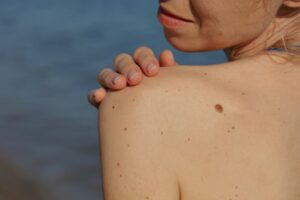My Mole Itches But Doesn’t Hurt, What Does This Mean?

Most moles are small, colored spots that don’t require any special treatment. However, there are health risks involved with moles that suddenly start transforming.
What is a mole?
A skin mole, also called a nevi, is normal and forms when skin cells, called melanocytes, grow in a cluster rather than spreading out. Most moles won’t develop into a problem, but sometimes they may become cancerous.
What is the difference between common moles and atypical moles?
Most moles are harmless, and these are known as common moles. They seldom become cancer, but there is more risk of cancer if you have more than 50 moles. Less common are atypical moles known as dysplastic nevi.
A common mole can be flat or a bump. Normal moles are one color: brown, tan, skin-toned, pink, red, blue or clear, and their size is smaller than 1/4 inch (5 millimeters) across. Common moles also are round shaped, even on both sides, and have a distinct, un-blurred border that separates them from the surrounding skin. Normal moles don’t change.
Atypical moles can also be flat or raised, but they measure more than 1/4 inch (6 mm) across and are unevenly shaped with irregular borders that may fade away into the skin surrounding the mole. Atypical moles are a combination of colors, and their surface may be smooth, uneven, rough, flaky, or bumpy.
Why might a mole be itchy, but not painful?
There are many different reasons why a mole could be itchy but not painful, and cancer is possible but not the most probable cause. Itching is caused when your skin's nerves are irritated. This irritation could be caused by chemicals that are applied to your skin, dry skin, peeling skin caused by a sunburn, and other reasons. However, an itchy mole could also be from changes within the mole itself, and changing moles need your attention.
In what ways can an itchy mole be treated?
If you notice changes to color, size, or shape of any moles, you should have them checked by a doctor. If you have a mole that bleeds, itches, feels tender, or it’s painful, it’s important to see a doctor as soon as possible. Most moles that are itchy, painful, large or have a potential for being cancerous are typically removed.
What are the signs that a mole might be malignant?
The ABCDE method sums up the signs that your mole might be melanoma:
- Asymmetry: One half of the mole doesn’t match the other half.
- Border: The mole has irregular, blurred, or ragged borders.
- Color: The mole has two or more different colors.
- Diameter: It’s larger than ¼ inch (6mm) across.
- Evolving/Elevating: The mole is changing size, shape, or color, or it’s becoming raised above the rest of the skin.
Can skin cancers cause itching?
Basal cell carcinoma (BCC) and squamous cell carcinoma (SCC) are the most commonly diagnosed types of skin cancer and are treatable. BCC and SCC can cause itching in about 40% of people. Itching in these cases is typically mild and goes away once the cancer is removed. Melanoma, the deadliest form of skin cancer, rarely causes itching.
If you notice a new mole or changes in an existing mole and want a skin cancer screening, visit our experienced dermatologists at the Skin Center of South Miami. We’re experts regarding skin exams and early cancer detection. We deliver personalized dermatology care for every person in every case. Call us at 305-740-6181 or fill out the form on this page to schedule a consultation today.